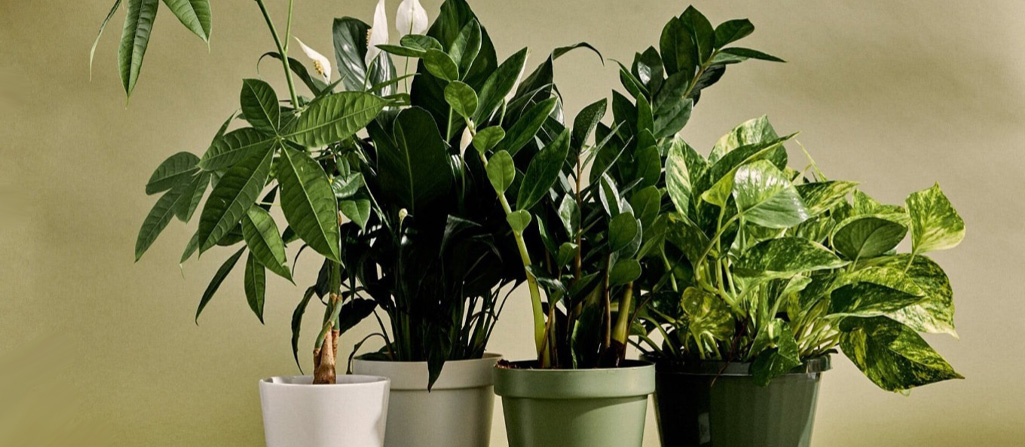Indoor plants do not need the same care in summer as in winter. It must be taken into account that with the arrival of cold weather, temperatures drop, the hours of daylight decrease and an element comes into play that complicates everything a little and that is called heating.
With the cold weather we must change some of our care habits:
Watering: reduce the frequency, quantity and timing of watering.
Humidity: provide more humidity.
Location: light and away from heating.
Fertilisation: do not fertilise the plants until spring.
Pruning: this is the time to clean damaged leaves.
Leaves: it is important to keep them clean.
Before explaining in more detail the care of indoor plants in winter, We think it is also important to explain what happens to plants when the cold weather arrives.
Plants feed on light and use all the energy provided by the sun to flower, put out new leaves and continue to develop.
We must not forget another fundamental factor in the development of a plant: temperature. Each plant has its own needs, but it is essential for them to have warm temperatures that allow them to continue growing.
With the arrival of winter and due to the drop in temperatures, plants enter a period of rest or vegetative rest.
As the temperature conditions are not optimal for their development, plants “reserve” all the energy provided by the sun during the winter in order to grow more vigorously in spring, when warmer temperatures arrive.
If this is so, why do some plants flower in autumn? It is true that there are plants such as flower in autumn. This is due to because these particular plants tolerate lower temperatures for growth and development.
However, when temperatures are lower than these plants need to thrive, they will also go into dormancy.
It depends on the climate, but whenever there is frost or the temperatures are really cold, yes, the plants will go into dormancy.
Moreover, this vegetative rest is essential for them because during these months they accumulate energy and “train” themselves to grow with greater vitality and strength with the arrival of spring. It is advisable for plants to enjoy at least two months of vegetative rest.
In cities with constant warm temperatures, plants do not have this rest and although they survive without it, they become weaker and more prone to attack by pests and fungi.

Now… Let’s get down to the nitty-gritty of plant care in winter! Please note that in this post I am going to talk about the care of indoor plants.
If you have plants outside or on your garden, check what temperatures these plants can withstand (lest you lose them to frost!). To protect them from excessive cold, you can buy strong transparent plastic and cover them at night with it or put them inside greenhouses that protect them from the cold.
There are three things to bear in mind when it comes to watering your plants in winter:
Frequency of watering: now that the temperatures are lower, the humidity in the soil lasts longer, so it is important to space out the watering. If in summer we watered twice a week, now watering once a week will be enough.
How do we know if we are watering too much or too little? Always pay close attention to the substrate. When it is time to water your plant, first look at the soil and check whether it is moist or not. But don’t just look at the surface, dip your finger into the substrate and assess how wet it is. If it is still wet, don’t water and wait a few days.
This is important because overwatering can cause fungus problems!
Amount of water when watering: as plants enter a period of rest in winter and their aerial activity (leaves and stems) comes to a standstill, they need less water to survive.
For this reason, we will also have to adjust the amount of water we give them and gradually reduce it.
Time of day to water: In summer, I like to water in the evening because it is so hot that the plants appreciate being cool and hydrated. However, this rule does not apply in winter.
Why not? Well, because at night the temperatures drop, the heaters are turned off and having the plant freshly watered at the coldest time of the day is not suitable for it.
In winter it is better to water during the day, for example at midday: there is light, there is sunshine and any excessive humidity caused by watering will leave the plant sooner.
Forgetting about humidity during the winter is a very common mistake. We think that because it is cold, plants are well hydrated and do not need humidity.
How can you know if your plants need humidity? Look at the tips of the leaves, are they dry or brown? If your answer is yes, it means that your plants need humidity.
But this is not the case. It is rather the opposite. In winter we have the heaters or radiators on and these provoke an environmental dryness that our plants are going to notice and suffer.
Providing them with humidity is relatively simple and you can do it in two ways: spraying their leaves from time to time or using a humidifier.
Another aspect to take into account during the winter is the location. Mainly for two reasons:
Lighting: in winter, the hours of light and its intensity decrease, so it is important to find a place in the house near light points so that they receive all the sun they need.
Heating: as far as possible, it would be a good idea to place your plants away from radiators, as direct heat can be harmful to them. In addition, sudden changes in temperature (from room temperature to heating) are not beneficial.

W have called it pruning because We didn’t know how to define this point, but more than pruning, We mean cleaning the plant.
That is to say, take advantage of the arrival of winter to cut those dry or yellow leaves that you think are going to dry out soon. We always recommend doing this so that the plant does not “waste” energy on leaves that will inevitably be lost and have no continuity.
During autumn and winter there are fewer hours of light and therefore the plant receives less energy or food. Our job here is to make it as easy as possible for them to take in as much light or energy as possible.
We have already mentioned that in winter plants should be placed in a place where they receive more light. But as you are well aware, plants capture light through their leaves, so it is essential to keep them clean so that they can feed properly.
Did you know that dust or dirt accumulated on the leaves can complicate photosynthesis? The truth is that the leaves would have to be very dirty to prevent them from absorbing the sun’s energy, but to avoid unnecessary risks, it is advisable to keep the leaves clean during the winter.
You can wipe them with a cloth dipped in water and pass it over each one. This way, they will be in perfect condition to make the most of the hours of light available during the winter.
We hope these tips will help you take care of your houseplants during the winter! Feel free to share with me any tips or questions! We’ll read you in the comments!
Last Edited: October 21, 2021
 5th March 2023
5th March 2023
 pedro
pedro
A gift-wrapped rose bush is a wonderful idea for Mother’s Day because it is not only a beautiful and thoughtful present, but it also symbolizes the love and appreciation you...
 19th March 2022
19th March 2022
 pedro
pedro
As a start to this long adventure of learning and helping you to learn more about our products, and gardening in general in the UK, we are going to start...
 18th March 2022
18th March 2022
 pedro
pedro
In this next post we will give our humble opinion, providing information about our irrigation techniques in Carbeth Plants. When should plants be watered One of the main mistakes we...




